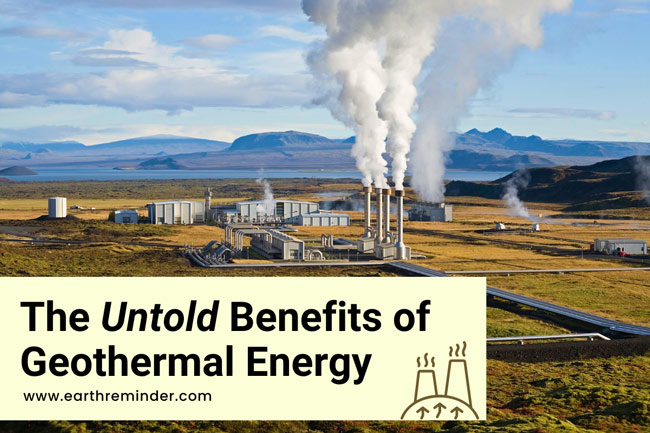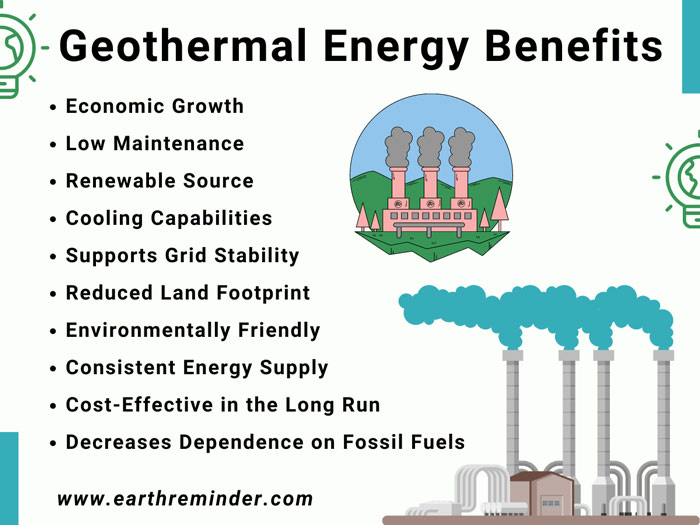10 Benefits of Geothermal Energy
The benefits of geothermal energy are becoming more and more important in the search for sustainable and clean energy. Geothermal is derived from the Greek words “geo” (earth) and “therme” (heat). A geothermal energy source is a heat from underneath the earth. You can use this heat to generate electricity, heat buildings, and much more. Geothermal energy comes out as an effective alternative to fossil fuels as we try to reduce our dependence on them. Here, we will understand what makes this renewable energy beneficial.
Table of Contents
What Are the Benefits of Geothermal Energy?
There are many benefits associated with geothermal energy, which makes it one of the most promising sources of clean, renewable energy. Geothermal power is capable of replacing fossil fuels as our world deals with climate change. The following are some of the main benefits of using geothermal energy:
Environmentally Friendly
Reduced Greenhouse Gas Emissions: A geothermal energy system produces minimal emissions, compared to fossil fuel burning, which releases carbon dioxide, sulfur dioxide, and other harmful substances into the atmosphere. Using geothermal energy doesn’t harm the planet as much. It reduces pollution and makes the planet healthier. We’ll be able to reduce our carbon footprint and combat climate change.
Renewable Source
Unlimited Supply: Earth’s heat will always be there for us as compared to fossil fuels such as oil, coal, and gas which can run out. Geothermal energy is considered renewable because this source of energy comes from the vast amount of heat within the Earth, which is basically inexhaustible.
The U.S. Department of Energy’s Geothermal Technologies Office highlighted in 2023 that the United States alone possesses over five terawatts of heat resources, sufficient to meet the global electricity needs, and millions of American homes could be powered just by capturing a fraction of that.
Cost-Effective in the Long Run
Stable Pricing and Savings: Starting with geothermal may be costly, but in the long run, it’s cheaper because it needs less money to continue operating. Hence, in the long run you will save and earn profits. Also, geothermal energy prices are less volatile than those of fossil fuels.
By 2035, the Department of Energy hopes to reduce the cost of Enhanced Geothermal Systems (EGS) by 90%, making it a cost-effective and widely adopted renewable energy resource.
Consistent Energy Supply
Reliable and Base-load Power: Sun or wind energy needs the right weather. Geothermal power plants don’t depend on sunlight, wind, or rain. Their energy output isn’t affected by time and seasonal changes, or unpredictable weather. This energy source is considered a base load power source, i.e. it provides enough power consistently and reliably.
Geothermal power plants operate at temperatures between 250° and 700°F. Direct heat applications, useful for space heating, industrial, and agricultural purposes, can utilize temperatures from 100° to 300°F. Even consistent temperatures of 50°–60°F, found just 10 feet underground, are sufficient for heating and cooling buildings and communities.
Reduced Land Footprint
Compact Infrastructure: Geothermal energy has a smaller land footprint, so it’s less impactful on the environment. Most of the infrastructure for geothermal energy is underground, such as wells and pipes. It also minimizes visual impact and footprint. Geothermal power plants can produce a lot of power from a small area. Because it uses the heat beneath the earth’s surface, it doesn’t need a lot of land, unlike solar or wind farms. A less disturbed land means fewer habitats are disturbed, which preserves biodiversity.
Low Maintenance
Durable Systems and Fewer Repairs: Geothermal systems require low maintenance, which is great for homes and offices. Geothermal power plants are made of tough materials that can handle geothermal fluids’ corrosive and abrasive nature. So, once built, the infrastructure will have a long lifespan. For example, solar panels might need cleaning or replacing after a storm, or wind turbines may need repairing after particularly strong winds, but geothermal plants usually don’t require much maintenance.
Economic Growth
Job Creation and Local Development: Geothermal power plants require skilled and unskilled labor to develop, build, and operate. This leads to many jobs in engineering, construction, operations, maintenance, and even in the supply chain that supports them. For example, research from Poland shows that geothermal municipalities generate more jobs compared to reference areas. Businesses involved in geothermal activities contribute to the growth of service and trade jobs.
Geothermal energy market was worth USD 59.4 billion in 2021. With a Compound Annual Growth Rate (CAGR) of 6.3%, it’s projected to reach USD 95.82 billion by 2029. It’s driving this growth with geothermal energy’s diverse applications in heat, cooling, and electricity generation, as well as technological advancements.
Also, any country can reduce its dependency on imported fuels by using geothermal energy, which helps improve its trade balance and keep money in the local economy. It also promotes local development since most geothermal resources are in rural areas.
Supports Grid Stability
Added Value to Other Renewables: Geothermal power plants can produce predictable results. Grid operators can plan for how much power will be supplied over time because energy extraction rates and conditions stay relatively constant. Also, geothermal contributes to grid stability on its own, but it can also be integrated with other renewables. For example, geothermal can fill in the gaps when solar or wind output is low, so the grid remains balanced.
Decreases Dependence on Fossil Fuels
Energy Security and Diversity: Geothermal energy helps reduce greenhouse gas emissions by reducing fossil fuel dependence. While geothermal plants release greenhouse gases, they’re much lower than coal or natural gas plants. As we discussed above, geothermal resources available locally can reduce the need for fossil fuel imports. It increases energy security and decreases a nation’s dependence on external energy.
Also, by integrating geothermal energy into the mix, we’ll be less dependent on one source. This diversification makes energy grids more resilient to supply fluctuations, which can happen because of geopolitical or supply chain issues.
Cooling Capabilities
Geothermal Heat Pumps: You can also use geothermal energy to cool down buildings in hot weather. Geothermal heat pumps are one of the best ways to use geothermal energy for cooling. These systems use the earth’s stable temperature to heat and cool buildings.
A GHP cools the building by extracting heat from the building and transferring it to the ground, especially in summer. By transferring heat from the ground to the air during colder months and vice versa during hotter months, GHPs are able to reduce energy costs by up to 50% and produce no direct emissions. GHPs save money on operating and maintenance costs, are quiet, have good humidity control, and contribute to a more resilient grid.
Conclusion
When we talk about the benefits of geothermal energy, we’re looking at a power source that’s both reliable and kind to our planet. A geothermal system uses the Earth’s heat to provide energy, all year round. It reduces our need for fossil fuels, which reduces greenhouse gas emissions. The use of geothermal energy will likely increase in the coming years, further enhancing its role as a sustainable and secure energy source. It’s also cost-effective after the initial setup. In short, geothermal energy gives us a cleaner, more economical, and steady energy source.

